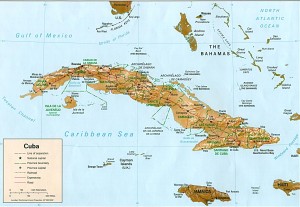 Cuba Population 2013
Cuba Population 2013
The current population of the Republic of Cuba is estimated to be about 11.164 million people, which is an estimated 0.76% decrease in the population since the last census was taken in 2011. The population of Cuba has consistently been larger than that of the Dominican Republic; however, the declining population of Cuba and the increasing population of the Dominican Republic indicate that the population of Cuba at some point soon will dip below that of the Dominican Republic’s population. Based on the total land area and the total population of the country, the population density of the country is 264 people per square mile.
Cuba Population Projection
Based on the birth, death, and migration rates of the Republic of Cuba, by the year 2020, the population is projected to reach 11.097 million people, which is a 0.6% decrease in the population. Then, by 2025, the population will reach 10.989 million people, a decrease of 1.6% from the current population. Continuing this trend, by 2030, the population will sink to 10.84 million people, a decrease of about 2.9% from the current population. Then in 2035, the population will reach about 10.618 million people, decreasing by about 4.9% from the current population. By 2040, the population will have decreased by about 7.4% to 10.336 million people. Lastly, by 2045, the population will have sunk below 10 million people as it reaches 9.956 million people, a total decrease of 10.8% over the next 32 years.
Cuba Demographics
Of the approximate 11.2 million people in the Republic of Cuba, about 51% of the country identifies as mulatto, which is a race of mixed ancestry. About 37% of the population identifies as white, and 11% identifies as black. The last 1% of the population is Chinese. Also, the main language spoken in Cuba is Spanish.
Religion in Cuba
Originally, the Castro era declared the Republic of Cuba an atheist state in 1962. Because of this, the large Roman Catholic influence on the island was diminished as over 400 schools were shut down. However, in 1992, the state was declared as secular instead of atheist, which allowed people to practice their faiths. The estimates for the actual percentage of the population participates in each faith are a little unclear. However, there did become a large decrease in the Roman Catholic population from before the Castro era to present day Cuba. There is a minor portion of the population that practices Afro-Cuban religions, which combines elements from African religions and Roman Catholicism.
Human Rights in Cuba
Cuba is the only Latin American country to still be on the Human Rights Watch list. The Cuban government, now run by Raul Castro, does not respect the rights of humans as it forces people to conform and accept the unfavorable government. People are beaten, placed in short-term detention center, forced exile, and even given travel restrictions solely as punishment for not conforming to the government. Some prisoners have been released only if they leave the country, however.
Healthcare in Cuba
Every healthcare service in the Republic of Cuba is public and run by the government. There are no privately owned practices or hospitals of any sort. Despite the public healthcare system, the staff of all the facilities is very well trained and has much experience. Historically, Cuba has been known to have one of the best healthcare systems in the world. Despite some hardships down the road due to lack of medical equipment, the Cuban government has been conducting projects to help secure the high status of the healthcare network.
 Education in Cuba
Education in Cuba
One of the consequences of the Cuban Revolution in the 1950s was that education for all citizens of the country became free and accessible. Because of this, the literacy of the country is almost 100%. However, the government, leaving only a few private and international schools, runs most of these schools.
Cuba Census


